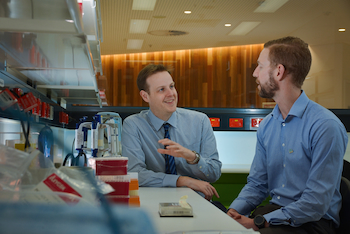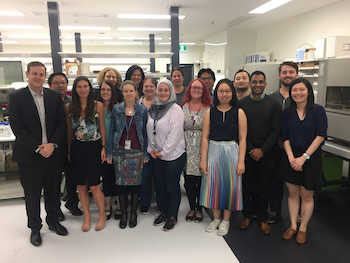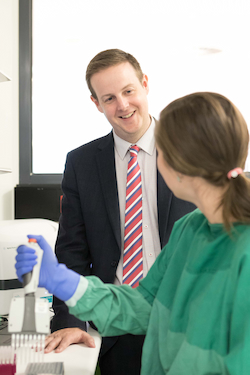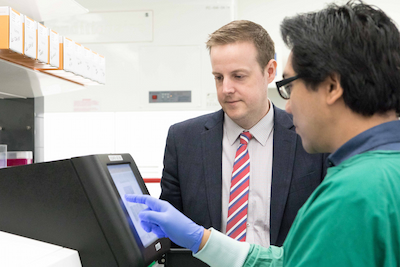Expert Series: Dr Piers Blombery on genomic testing
Genomic testing is now at the centre of care and improving outcomes for patients with blood cancer, says Dr Piers Blombery, a clinical and laboratory haematologist who runs the molecular testing lab at Peter MacCallum Cancer Centre in Melbourne. It’s the largest molecular haematology diagnostic laboratory in Australia, currently testing 10,000 samples per year. Dr Blombery explains the basics of molecular testing which informs the treatment of blood cancer.
Leukaemia, lymphoma, haematological malignancies, in fact all cancer is derived from the fact that we acquire mutations in our DNA throughout the course of our life, explains Dr Piers Blombery.
“DNA is essentially the blueprint; it’s like the recipe book to make all the proteins in our cells. And every time a cell divides, it has to faithfully copy that recipe book, word-for-word into the new cell.

“If it makes any mistakes, we call that a mutation, and that can go on to lead to an abnormal protein, which, if you get enough of them, can go on to lead to cancer.”
What is genomic testing?
In the case of a particular leukaemia or other blood cancer, the aim of genomic testing is to look at all the mutations that have driven the change from a normal cell into a cancerous cell.
“By doing genomic testing and looking for those mutations, we can work out whether all those mutations fit with a certain leukaemia or a certain lymphoma. It can tell us what the prognosis of that patient is, whether this lymphoma or leukaemia is going to act aggressively or not. And it can also tell us, potentially, what therapies the patient will respond to and what the Achilles heel of their leukaemia or lymphoma is,” said Dr Blombery.
“So essentially, genomic testing is the process of reading that recipe book from cover to cover and working out where all the spelling mistakes are and then exploiting those to make a diagnosis, work out the prognosis or define a treatment for the patient.”
“Almost all blood cancer benefits from genomic testing in some way or another,” he said.
“Some types of blood cancer need lots of genes tested for and some need very few, but it really spans the entire diagnostic and treatment journey for blood cancers.”
Using genomic testing to make a diagnosis
Dr Blombery said there are three broad spheres in which to consider the usefulness of genomic testing – diagnosis, prognosis, and treatment.
“At the start, every patient needs the correct diagnosis to get the correct treatment. If you don’t have the right diagnosis, you can never get the right treatment,” he explained.
“Genomic testing can tell us exactly what sort of blood cancer a patient has.”
“Compare this to looking down a microscope at a lymphoma and saying, ‘the cells are big, they’re round, and they’re B-cells, therefore, we’ll call it big round B-cell lymphoma. That’s an oversimplification, but that’s honestly the way some of these things are classified.
“Contrast that to defining 100,000 genes as a continuous variable in these patients; which ones are up, which ones are down? And splitting those lymphomas into eight different molecular subgroups, all of which have different prognoses and treatments, and different ways of responding to therapies.
“Then you can really see how you can turn diagnoses from a relatively blunt tool into a really precise art. That’s how genomic testing is used initially.”
Dr Blombery said blood cancer is unique because blood, by its position in the body, reacts to the outside world.
“Your white cells go up when you get an infection, your platelets can go up when you get iron deficiency, your red cells can go down when you get renal failure.
“Blood is very reactive, and those three things – high white cells, high platelets, and low red blood cells – can also be the sign of blood cancer.”
“Therefore, genomic testing has a very important role in working out when something is a cancer or simply an infection or iron deficiency or another cause, like renal failure, because you don’t see those mutations in patients who have, what we call, a reactive cause to their blood abnormalities.
“Whereas, if we detect lots of mutations, we know this isn’t an Epstein-Barr virus infection or iron deficiency, this is actually chronic myeloid leukaemia (CML) or essential thrombocythemia (ET) or all the other diagnoses which we make,” said Dr Blombery.
“And that doesn’t tend to be the case for solid organ cancer like breast cancer and bowel cancer because those organs aren’t the same as the blood, which is such a dynamic, reactive organ.
“Making a proper diagnosis is 70-80% of genomic testing in patients with blood cancer,” said Dr Blombery, who believes clinical trials should be as biomarker- and genomics-driven as possible.
If T-cell lymphoma consists of over 50 different subtypes, all with different biology, then why do we have clinical trials for T-cell lymphoma with a targeted agent that enrols any of the 50 subtypes?”
Using genomic testing to determine a patient’s prognosis
Dr Blombery went on to explain that when some mutations are present in a leukaemia, he knows that those patients might have a very good prognosis and may require less treatment.
“And in other patients, we might have a poorer prognosis, and they require more intensive therapy to have the same outcome.
“That’s particularly the case in acute myeloid leukaemia (AML), where we look for 25 or so genes, and based on the mutations in those 25 genes, we can work out whether someone needs to have a stem cell transplant or can just have chemotherapy alone. That’s tied to the prognosis of the patient and how these genes determine their response to therapy.
“Then there are these genes that are specifically targetable by drugs, so we find a mutation in a gene and a patient gets a drug which acts on that gene and the patient goes into remission.
“That’s obviously great when it happens, but it’s quite rare, because cancer is not as simple as a one target type of scenario, outside of very specific examples, like CML.
“In general, cancer doesn’t stay in remission very long when you just attack one target, and that’s not the most common benefit from genomic testing.”
Different types of genomic testing
Dr Blombery went back to his DNA recipe book analogy to explain different testing scenarios.
“If you know a disease is caused by a spelling mistake in line four on page 35, where there should be a D but there’s an F and you know that’s all you care about, then all you have to do is a very simple assay which looks at just that change, in and of itself,” he said, giving the example of JAK2 testing in myeloproliferative neoplasms (MPN).
“That’s probably the most common test in genetic haematology, and it’s looking for a very single spelling error on a specific page in a specific line.”
“That’s fine for polycythaemia vera (PV) but then if you take ET, another MPN that is closely related to PV, those ET patients can have the JAK2 mutation, and half of them do, but the other half have mutations in CALR and MPL. So there are two other genes you need to look for – the equivalent of having to check on page 50.

“Unfortunately, there are lots of different CALR mutations, so it’s not as simple as looking for a specific spelling mistake. You have to check four or five paragraphs for those spelling mistakes, and then you’ve got to go and check another page for MPL and check whether it’s got a whole bunch of spelling mistakes.
“By now you’re looking at multiple pages, for multiple spelling mistakes, in multiple paragraphs in that recipe book. It becomes quite unwieldy to look for all these by single assays, so you need a technology which allows you to look at all those genes simultaneously, and that’s what we call next generation sequencing,” said Dr Blombery.
Looking at a small number of genes (a small number of paragraphs and pages) is called targeted sequencing. Then whole exome sequencing (also called whole genome sequencing) is like reading the entire recipe book, from the publisher’s note at the start to the publisher’s note at the end and everything in between, to find any spelling mistakes anywhere.
This takes vastly more resources and time than targeted sequencing, and while it gives a lot more information, Dr Blombery said, “it’s not necessarily clinically translatable into action”.
With targeted sequencing, the mutations that are being searched for can be interpreted.
“So if I find a mutation in gene X, then the patient has disease Y. And I know if I find a mutation in gene A, then the patient needs treatment B. But I may have no idea about what to do if someone’s got a mutation in gene F, so in a clinical context, there’s little point in me knowing that gene F is there if it’s not important to the patient.”
But the scenario is completely different for research, where Dr Blombery said “it’s all about gene F – finding mutations in gene F, trying to work out what these mutations are that we don’t know what to do with yet, and translating those into the clinic”.
“But purely from a clinical viewpoint, which is where I practice, targeted sequencing is currently the sweet spot of things that we know what to do with; looking for a defined set of abnormalities which we can implement in the clinic.”
You may have heard of the term, gene panel, and Dr Blombery said that’s just another description for targeted sequencing.
“Targeted sequencing can refer to five genes or 100 genes, but generally when you get to above 1000 genes, it makes more sense to go to whole exome sequencing.
“And next generation sequencing just refers to the technology used to perform targeted sequencing or whole exome sequencing.”
When it comes to who pays for a genomic test, Dr Blombery said, “the majority of testing isn’t funded by the Medicare Benefits Schedule and this generates inequity of access”.
“It is variable who pays for testing, it may be the patient, individual hospital pathology departments or more rarely, insurance companies.
“The only way to get fair and equitable access to testing is for it to be federally reimbursed,” he said.
What’s involved in having a genomic test done?
“When we’re looking for mutations in a patient’s cancer, we need a cancer sample and we do the genomic testing on that material,” said Dr Blombery.
“If it’s a leukaemia, and enough cancer cells are circulating in the blood, we use a blood sample. If the cancer cells are only present in the bone marrow, like myeloma, then we need to take a bone marrow biopsy, and for lymphoma, which is only present in the lymph node, then we need the sample from a lymph node biopsy.
“Generally, we use samples that have already been taken during diagnostic testing, and it’s rare for someone to have a test specifically done for genomic testing.”
Dr Blombery said there were two important things to say about the sample type used for the genetic profile. The first is the discovery of circulating tumour DNA; a relatively new discovery that has been available at Peter MacCallum Cancer Centre (Peter Mac) for a couple of years.

“The fluid that bathes all the cells in your blood is a representation of all the DNA activity that’s happening in your body,” he explained.
“It’s thought that as cells die, they leach out their DNA which goes into this fluid before being metabolised by the liver and broken down and recycled. We can exploit that by capturing that circulating tumour DNA (ctDNA) [also called cell-free DNA (cfDNA) or a liquid biopsy] and use it to do genomic testing on.
“That’s particularly useful when someone has something like myeloma, where it’s only present in the bone marrow or we think someone has lymphoma and the lymphoma is at a very difficult biopsy site – perhaps deep in the abdomen or in the brain.
“We can do a simple blood test, find the DNA molecules in the circulating tumour DNA, and test that, and we get the same results, and sometimes more results, than from testing the tumour itself.”
Barriers to accessing genomic tests
Most patients with blood cancer will get some sort of genomic testing and Dr Blombery said, “there aren’t many circumstances now in haematology where it’s not useful”.
“Ideally, you’d want to see that closer to 100% of patients are being genomically tested, but that varies based on whether people are in the bigger cities or live rurally, due to access and the unfortunate disparities of care that sometimes exist.”
Discussing the barriers to accessing genomic testing, Dr Blombery said not all haematologists know of its relevance to their practice.
“I have a hard-enough time keeping up with all the new information myself, let alone to expect people who are treating diverse haematological malignancies, as well as general haematology and potentially other sorts of cancers, to be across it.
“Haematologists also need to have a good relationship with molecular labs which they can call on to provide expertise.
“So it depends on the doctor’s knowledge and also the ability to access the testing by sending in the samples.
“We do lots of testing for patients in regional Australia and rural Victoria, but we want to see testing available to everyone and accessible to everyone, regardless of where they live.”
Dr Blombery highlighted that, “there is no testing that is done overseas that cannot be (and is not) done in Australia. Unfortunately, many physicians look overseas before they look in their own backyard”.
“There’s so much information available on the internet and patients are getting increasingly motivated, which is great to see. Often patients will raise genomic testing with their doctor, and pleasingly, the process is either already underway or part of what the doctor was planning anyway.
“It’s always helpful to have the patient advocate for genomic testing or to ask their doctor, ‘is genomic testing useful in my circumstance?’.
“It might not be, but it might be, and that can be the prompt that can get the doctor to look into it and then order the test.
“And, yes, patients call our laboratory and ask, ‘how do I access testing? What do I do? Where do I get my doctor to send the blood test?’,” said Dr Blombery.
The importance of genomic testing in CLL
Dr Blombery said it is essential that people with CLL are genetically tested before they start chemotherapy treatment because there are two groups of patients – those with mutations who do not respond to the standard therapy and those with mutations who do “profoundly better” on targeted therapies.
Find out more in a separate article, Genomic testing for mutations critical for CLL patients pre-treatment
Issues around genomic testing
Dr Blombery said the main issue for patients comes from sometimes finding mutations that are present in a patient’s germline.
“What that means is that patients were born with those mutations, and when patients are born with those mutations they can sometimes have a predisposition to having blood cancer, and blood cancer can run in their families.”
These inheritable mutations are rare, occurring in only .5% of cases, but Dr Blombery said, “it’s something to be aware of; that it is a possibility”.
“In these cases, there are implications for siblings, parents, and children of that patient about whether they need to get tested for that same gene.
“It’s incredibly rare to detect those mutations, and it’s not a bad thing to detect those mutations because it helps to manage the rest of the family.”
Dr Blombery said all haematological malignancies can run in the family, with the most common being clusters of MPN and CLL that run in families.
“The other major ones are some of the myeloid malignancies such as AML, which can be caused by some mutations in some new genes that have just been discovered, genes like DDX41 and RUNX1.”
Genomic testing and differential diagnoses
Commenting on the process of differentiating between two or more conditions which share similar signs or symptoms, Dr Blombery said, “you might think, how the hell can a doctor not know the difference between infection and leukaemia?”.

“Obviously it’s easy to diagnose each one but it gets more subtle and it can be quite difficult to distinguish chronic infections from different leukaemias, and chronic conditions from MPNs.
“Genomic testing can sort that out in one fell swoop, and either reassure the patient that they’ve got an infection and don’t have a haematological malignancy or diagnose that haematological malignancy and start appropriate treatment, because antibiotics don’t work for leukaemia and chemotherapy doesn’t work for infections.”
While Dr Blombery said the first battle was to get to a diagnosis of blood cancer, the second battle was to work out, “which of the almost 1000 different blood cancers is this?”.
Genomic testing helps in both instances and helps define the diagnosis into individual subtypes to guide treatment.
Dr Blombery also said that patients may need multiple tests across their treatment journey, depending on the disease and their response.
“Testing in the case of relapsed disease can give insights into why the patient may have become resistant (particularly to targeted therapies) and what to try or not try as a next treatment.”
Choosing the right genomic test
“We want to provide the right test for the right patient for the right diagnosis at the right time and that isn’t just performing whole genome sequencing on everyone that comes through the door… it’s using it judiciously,” said Dr Blombery.
The JAK2 test for patients with PV, and 95% of these patients will have the JAK2 mutation, costs $50 and takes a couple of days, whereas whole genome sequencing costs thousands of dollars and can take many weeks.
Contrast that with acute lymphoblastic leukaemia (ALL) or B-cell ALL, the most common childhood leukaemia, which is also relatively common in adults, as well.
“Those patients can have hundreds of abnormalities and they can be very complex abnormalities affecting lots of genes, and genes can be stuck together, and they can be amplified, and they can be lost,” explained Dr Blombery.
“It would be completely unfeasible to do individual gene tests to find every single lesion you need to find in order to treat that patient properly, and in that case, whole genome sequencing is ideal, because you’re looking for diverse abnormalities – you’re looking at a diverse array of genes – which have profound effects on patient care. And in that case, whole genome sequencing is very worthwhile.
“That’s what we’re doing here, in collaboration with the University of Melbourne with Professor Sean Grimmond.
“We’re doing whole genome sequencing of patients with ALL to find these abnormalities, and then everything else, the spectrum in between.
“As I said, in CLL the most important thing is p53 and IGHV, so that’s two or three genes for CLL. In AML, there’re 20-25 genes which determine whether you need a stem cell transplant or not. And then you get to things like diffuse large B-cell lymphoma (DLBCL) where you might have to look at 100-200 genes, so it’s really about using the right test for the right patient, for the right diagnosis, at the right time.”
“More and more haematologists are asking for next generation sequencing, and the laboratory provides the expertise as to what to test for.
“Generally, the laboratory does the investigative testing and tailors it to the patient, from what we know about the patient – from the request slip and the histology – and then our discussions with the doctor.”
How Dr Blombery came to specialise in genomic testing?
After graduating from Melbourne University, it was during his training at St Vincent’s Hospital that Dr Blombery had an inspiring registrar, “in terms of his clinical acumen and research and intellectual pursuits in haematology”.
“I always knew in the back of my mind that I wanted to be a similar sort of doctor to him.”
The other thing that attracted him to haematology, in those junior doctor days, was the integration of research into the care of patients with a haematological malignancy, and how quickly the field was moving.
“New treatments were coming out all the time, so haematology always seemed like a quite exciting thing to get into.”
“Most haematologists are both clinically and laboratory trained,” said Dr Blombery, and he did his haematology training and years in the laboratory, at Peter Mac.
“When I was doing my pathology training, they discovered a mutation – BRAF V600E – in hairy cell leukaemia (HCL), which was a real breakthrough and opened the door to lots of targeted treatment for this incredibly rare type of leukaemia.
“In the lab, we had an assay that could test for BRAF V600E, as it was quite a common mutation in melanoma, and we applied it to HCL.
“That’s how I started off down the molecular road and it’s just got more and more complex since then.”
Dr Blombery then went overseas and at University College Hospital (London) he became more specialised in haematology and moved into molecular haematology.
When he returned to Australia, he went back to Peter Mac as a clinical and laboratory haematologist, then headed up precision genomics in molecular haematology, six years ago. While molecular testing has been around for a long time in haematology, it’s only since the invention of next generation sequencing that it has become “an all-encompassing specialty”.
“Peter MacCallum Cancer Centre was at the forefront of that five years ago,” said Dr Blombery.
“We process about 10,000 samples per year of which 5000 are next generation sequencing and about 5000 are just our standard molecular testing.
“There’s a large research component, as well, to what we do in terms of translational diagnostics and translational research programs.
“We hire a diverse range of staff including bioinformaticians, technicians, scientists, software engineers, genetic counsellors, project managers, Fellows, PhD students, post-docs, and clinical researchers.
“In the molecular haematology part of the laboratory, there’s about 30 to 35 staff members, so it’s a big team, and that’s all dedicated to molecular testing in patients with blood cancer.
“So, only a handful of haematologists in Australia run the testing, interpret the results and write clinical reports for clinical haematologists throughout Australia, who use these results in the care of their patients.
“Hopefully that’ll increase as the testing becomes more widespread and more accessible,” said Dr Blombery, who is also a clinician.
He sees patients with aggressive lymphoma and complex genetic problems, both inherited and those with genetic problems in their tumours which need specialist interpretation for their particular case.
Talk to your haematologist about whether genomic testing is called for or email [email protected]
* FCR is a combination of the chemotherapy drugs, fludarabine and cyclophosphamide, and the targeted therapy, rituximab.
Last updated on January 3rd, 2023
Developed by the Leukaemia Foundation in consultation with people living with a blood cancer, Leukaemia Foundation support staff, haematology nursing staff and/or Australian clinical haematologists. This content is provided for information purposes only and we urge you to always seek advice from a registered health care professional for diagnosis, treatment and answers to your medical questions, including the suitability of a particular therapy, service, product or treatment in your circumstances. The Leukaemia Foundation shall not bear any liability for any person relying on the materials contained on this website.